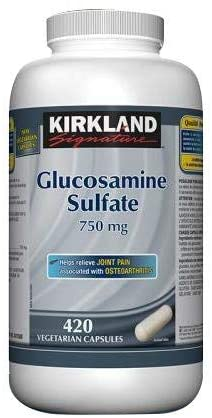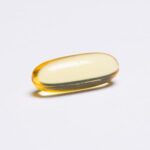Glucosamine sulfate and glucosamine hydrochloride are dietary supplements. Research conducted on animals has shown that glucosamine has the potential to both delay the degradation of cartilage and facilitate the repair of damaged cartilage.
However, when it comes to using glucosamine for osteoarthritis in humans, the outcomes have been mixed, and the observed effects have generally been modest. Recent studies and those employing higher-quality research methods have shown less likelihood of a beneficial effect. Evidence regarding the use of glucosamine hydrochloride is limited and lacks convincing support.
- Category: Dietary Supplement
- Scientific Names: Glucosamine sulfate, glucosamine hydrochloride
- Alternative Names: GS, amino monosaccharide, sulfated monosaccharide, chitosamine, D-glucosamine
Glucosamine is an amino sugar derived from shellfish or synthesized in laboratories. It is available in two variants: glucosamine sulfate and glucosamine hydrochloride, both of which can be purchased from various retail outlets.

How Does Glucosamine Sulfate and Glucosamine Hydrochloride Work?
Glucosamine sulfate and glucosamine hydrochloride are dietary supplements that are often used to manage the symptoms of osteoarthritis, but their mechanisms of action are not fully understood. While the exact mechanisms are still a subject of research and debate, here is a general overview of how these forms of glucosamine are thought to work:
1. Cartilage Building Blocks: Glucosamine is a naturally occurring compound found in the body and is a key component of cartilage, the tough tissue that cushions the joints. When taken as a supplement, both glucosamine sulfate and glucosamine hydrochloride are believed to provide the building blocks needed for cartilage repair and maintenance. This is because glucosamine is a precursor to glycosaminoglycans, which are essential components of cartilage.
2. Anti-Inflammatory Effects: Some researchers believe that glucosamine may also have anti-inflammatory properties. Inflammation in the joints is a hallmark of osteoarthritis, and reducing this inflammation can help alleviate pain and stiffness. Glucosamine may help modulate inflammatory processes in the joint, although the exact mechanisms are not fully understood.
3. Synovial Fluid Production: Glucosamine has also been suggested to stimulate the production of synovial fluid, which is the lubricating fluid that surrounds and cushions the joints. Enhanced synovial fluid production could potentially improve joint function and reduce friction, leading to less pain and stiffness.
4. Chondroprotective Effects: Glucosamine has been proposed to have chondroprotective effects, meaning it may help protect existing cartilage from further damage. This protection could slow down the progression of osteoarthritis.
It’s important to note that while these mechanisms make theoretical sense, the clinical evidence regarding the effectiveness of glucosamine supplements for osteoarthritis is mixed and varies from person to person. Some studies have shown modest benefits, while others have not found significant improvements. The effectiveness of glucosamine may also depend on factors such as the form of glucosamine used (sulfate or hydrochloride), the dosage, and individual response.
Additionally, research into the safety and efficacy of glucosamine is ongoing, and healthcare providers often consider it as part of a broader approach to osteoarthritis management, which may include other treatments like medications, physical therapy, and lifestyle modifications. Before starting any dietary supplement, including glucosamine, it’s essential to consult with a healthcare professional to discuss its appropriateness for your specific condition and to determine the most suitable treatment plan.
How Much Glucosamine Should You Take?
In most studies on treating osteoarthritis, the typical dose was 500 milligrams of glucosamine sulfate, three times a day. Ask your doctor what they recommend for you. Some experts suggest you take it with meals to prevent an upset stomach.
Glucosamine and Ibuprofen
Glucosamine and ibuprofen are two different types of treatments that are often used for osteoarthritis (OA), but they work in different ways and have distinct benefits and potential risks. Here’s an overview of each treatment and how they are commonly used for OA:
Glucosamine:
- Mechanism of Action: Glucosamine is a dietary supplement that is believed to provide the building blocks for cartilage repair and may have anti-inflammatory properties. It is thought to support joint health by helping to maintain and repair the cartilage that cushions the joints.
- Usage: Glucosamine is often taken as an oral supplement (usually as glucosamine sulfate or glucosamine hydrochloride) in the form of capsules, tablets, or powders. It is typically used as a long-term treatment for osteoarthritis.
- Effectiveness: The effectiveness of glucosamine for OA is a subject of debate, and research results are mixed. While some people report relief from joint pain and improved function with glucosamine, others do not experience significant benefits.
- Safety: Glucosamine is generally considered safe for most people when taken at recommended doses. Side effects are usually mild and can include digestive issues like nausea, diarrhea, or constipation. It is essential to consult with a healthcare provider before using glucosamine, especially if you have any underlying medical conditions or are taking other medications.
Ibuprofen:
- Mechanism of Action: Ibuprofen is a nonsteroidal anti-inflammatory drug (NSAID) that works by reducing inflammation and providing pain relief. It helps alleviate joint pain, swelling, and stiffness by inhibiting inflammatory processes in the body.
- Usage: Ibuprofen is available both over-the-counter (OTC) and in prescription-strength forms. It can be taken orally in tablet or liquid form or applied topically as a cream or gel. It is often used on an as-needed basis to manage pain and inflammation associated with OA.
- Effectiveness: Ibuprofen is generally effective at providing short-term pain relief and reducing inflammation associated with OA. However, it does not address the underlying cause of OA or promote cartilage repair.
- Safety: Ibuprofen can have side effects, especially when used in high doses or over an extended period. Common side effects include gastrointestinal issues (stomach ulcers, bleeding), increased blood pressure, and an increased risk of heart problems. Long-term or excessive use of NSAIDs should be monitored by a healthcare provider.
Glucosamine is Spongy Tissue Rebuilder
Glucosamine is sometimes referred to as a “spongy tissue rebuilder” because it is believed to play a role in supporting the health and repair of spongy tissues like cartilage. Cartilage is a type of connective tissue found in joints, including the knee, hip, and shoulder joints, as well as in the discs of the spine. It serves as a cushion and shock absorber, allowing smooth joint movement and reducing friction between bones.
Glucosamine is a naturally occurring compound that is involved in the formation and maintenance of cartilage. It is thought to provide the essential building blocks necessary for cartilage repair and synthesis of glycosaminoglycans, which are components of cartilage. As a result, some people use glucosamine supplements with the hope of supporting the health of their cartilage and potentially aiding in the repair of damaged cartilage, particularly in conditions like osteoarthritis.
It’s important to note that while many people believe in the potential benefits of glucosamine for joint health, the scientific evidence regarding its effectiveness is mixed, and results can vary from person to person. The use of glucosamine should be discussed with a healthcare provider, especially if you are considering it as part of a treatment plan for conditions like osteoarthritis. Additionally, it’s important to consider other treatments and lifestyle modifications that may be recommended by a healthcare professional to manage joint health effectively.
Side Effects of Glucosamine
Glucosamine is generally considered safe for most people when taken at recommended doses, and serious side effects are rare. However, like any dietary supplement or medication, it can potentially cause side effects in some individuals. Here are some of the common side effects associated with glucosamine:
- Digestive Issues: Gastrointestinal symptoms are the most commonly reported side effects of glucosamine. These can include nausea, diarrhea, constipation, indigestion, and abdominal pain. Taking glucosamine with food or dividing the dose throughout the day may help reduce these side effects in some individuals.
- Allergic Reactions: Although rare, some people may have an allergic reaction to glucosamine, especially if the supplement is derived from shellfish. Symptoms of an allergic reaction can include itching, hives, swelling of the face or throat, difficulty breathing, or rash. If you are allergic to shellfish, it’s essential to choose a shellfish-free glucosamine supplement.
- Blood Sugar: There have been concerns that glucosamine may affect blood sugar levels, particularly in people with diabetes. While some studies have suggested a potential link, the evidence is not strong, and glucosamine is generally considered safe for people with diabetes. However, if you have diabetes and are considering taking glucosamine, it’s advisable to monitor your blood sugar levels closely and consult with your healthcare provider.
- Increased Bleeding Risk: There have been reports of glucosamine potentially increasing the risk of bleeding, especially when taken in high doses. If you are taking blood-thinning medications (anticoagulants) or have a bleeding disorder, it’s essential to discuss the use of glucosamine with your healthcare provider.
- Liver Function: Some isolated cases of liver function abnormalities have been reported in people taking glucosamine supplements, but a direct link has not been firmly established. If you have liver disease or are taking medications that affect your liver, consult with a healthcare provider before using glucosamine.
- Other Rare Side Effects: Rare side effects may include headaches, skin reactions, drowsiness, and changes in heart rate. These side effects are infrequent and typically not severe.
It’s important to remember that the safety and efficacy of dietary supplements, including glucosamine, are not regulated as rigorously as prescription medications. Therefore, it’s crucial to consult with a healthcare provider before starting any new supplement, especially if you have underlying medical conditions or are taking other medications.
Can You Get Glucosamine Naturally From Foods?
There are no significant natural food sources of glucosamine. Glucosamine is a compound that is naturally produced in the human body and is also found in small amounts in the shells of shellfish. However, the amount of glucosamine obtained from dietary sources is typically insufficient to provide therapeutic benefits for conditions like osteoarthritis.
Most of the glucosamine used in dietary supplements comes from the processing of shellfish shells, such as crab, shrimp, and lobster shells. This extracted glucosamine is then used to create glucosamine supplements in various forms, including glucosamine sulfate and glucosamine hydrochloride.
Since dietary sources of glucosamine are limited and not practical for obtaining therapeutic amounts, people who use glucosamine for joint health typically rely on supplements. However, it’s important to be aware of the source of glucosamine in these supplements, especially if you have allergies to shellfish or other dietary restrictions. Some glucosamine supplements are derived from non-shellfish sources for those who need an alternative.
As with any dietary supplement, it’s advisable to consult with a healthcare provider before starting glucosamine, especially if you have specific dietary concerns, allergies, or underlying medical conditions. They can help you choose a suitable glucosamine product and determine the right dosage for your needs.
Glucosamine Interactions
Glucosamine supplements can potentially interact with certain medications and medical conditions. It’s essential to discuss any potential interactions with your healthcare provider before starting glucosamine, especially if you are taking other medications or have underlying medical conditions. Here are some common interactions and considerations:
- Blood-Thinning Medications (Anticoagulants): Glucosamine may have a mild antiplatelet effect, which means it could potentially increase the risk of bleeding when taken in conjunction with blood-thinning medications like warfarin (Coumadin), aspirin, or other anticoagulants. It’s crucial to monitor your blood clotting parameters closely if you are combining glucosamine with these medications.
- Insulin and Blood Sugar Medications: Some studies have suggested that glucosamine may affect blood sugar levels, potentially making them rise. If you have diabetes and are taking insulin or other medications to control your blood sugar, consult with your healthcare provider. You may need adjustments to your diabetes management plan if you decide to use glucosamine.
- High Blood Pressure Medications: There have been reports of glucosamine potentially increasing blood pressure. If you have high blood pressure and are taking medications to control it, discuss the use of glucosamine with your healthcare provider, as blood pressure may need to be monitored more closely.
- Nonsteroidal Anti-Inflammatory Drugs (NSAIDs): Glucosamine and NSAIDs like ibuprofen have different mechanisms of action, but both are often used for joint pain. If you are taking NSAIDs, adding glucosamine may affect how you manage your pain, so consult with your healthcare provider to ensure a safe and effective approach.
- Shellfish Allergies: Many glucosamine supplements are derived from shellfish shells. If you have a known shellfish allergy, it’s important to choose a glucosamine supplement that is shellfish-free and derived from alternative sources, such as fungal fermentation.
- Kidney Function: If you have kidney disease or impaired kidney function, consult with your healthcare provider before taking glucosamine, as it may affect kidney function or interact with medications used to manage kidney conditions.
- Liver Function: While rare, there have been reports of liver function abnormalities in some individuals taking glucosamine supplements. If you have liver disease or are taking medications that affect your liver, consult with your healthcare provider before using glucosamine.
- Pregnancy and Breastfeeding: The safety of glucosamine supplements during pregnancy and breastfeeding is not well-established, so it’s advisable to consult with a healthcare provider before using them during these periods.
- Surgery: If you are scheduled for surgery, it’s important to inform your surgeon and anesthesiologist if you are taking glucosamine supplements, as they may affect blood clotting or interact with anesthesia medications.
It’s crucial to provide your healthcare provider with a complete list of all the medications, supplements, and medical conditions you have when discussing the use of glucosamine. They can help you make an informed decision and monitor for any potential interactions or adverse effects.
Pain Medications, Pain Relief, and Pain Management







